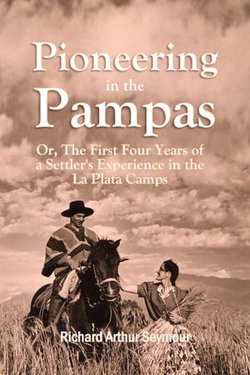"A plain unvarnished narrative of a settler's experience during four years of sheep farming in South America...the best guide we have seen to a country destined to become an unattached British settlement." Morning Post (London), Dec. 4, 1896
"Cattle-marking in South America is one of the great events of the year ... the picturesque-looking Gaucho, whirling his lasso round his head, and throwing it with unerring aim, adds an indescribable wildness to the whole scene." Richard Arthur Seymour
Richard Arthur Seymour (1843-1906) as he tells us, sailed from Liverpool in January, 1865, with the intention of making a rapid fortune by cattle and sheep-farming in the Argentine Republic. In his 1869 book "Pioneering in the Pampas" before us he gives an unpretending plain unvarnished narrative of a settler's experience during four years of cattle and sheep farming on the Pampas of South America.
The author and his companion, after having gained some experience in Entre Rios, resolved to try sheep farming in the remoter province of Cordoba, where the advantages of scenery, comfort, and security are less, but the price of land more moderate. They accordingly purchased for sixpence an acre a tract four square leagues in extent on the southern bank of the Saladillo, and had the doubtful satisfaction of finding that they were the first English residents between that river and Cape Horn.
The sort of " Robinson Crusoe " life which they led in this "location" is well described by Mr. Seymour. They had, of course, to build their own house, enclose their corral and yards, fence their land (a hard matter where wood is scarce), and even on occasions to make their own bricks. But these labours, together with the constant care of 3,000 sheep and other stock, could not prevent them from suffering from that ennui which most Englishmen experience at first who have exchanged civilization among their fellows for an existence in which the visit of a Guacho is regarded as a cheerful event. Hunting was their favorite amusement. During the first year the party managed to bag six lions and a wolf or two, and could always have great sport among the wild fowl.
Seymour seems to have been satisfied on the whole with the result of his farming, the chief drawback having been his Indian neighbors, who occasionally came down, like the cohorts of old, and swept off his cattle and his horses and his mules and his sheep. They helped themselves to twelve hundred of Mr. Seymour's flock, besides his few remaining horses. Doubtless they were uncomfortable neighbours; and it is not pleasant to live in a country where bands of well-mounted thieves are constantly prowling about, ready at one swoop to carry off all the flocks and herds which your profit are founded.
There was, of course, a civil war going on more or less at intervals, and moreover, the whole available force of the Republic was till lately employed in the war against General Lopez. The consequence was that there were no available forces for defending the settlers in Mr. Seymour's district against Indian attacks.
The part of the Spanish population with whom he came chiefly in contact were the Guachos. A gaucho or gaúcho is a skilled horseman, reputed to be brave and unruly. The gaucho is a national symbol in Argentina, Chile (Chilean Patagonia), Brazil, and Uruguay. Gauchos became greatly admired and renowned in legends, folklore and literature and became an important part of their regional cultural tradition. Beginning late in the 19th century, after the heyday of the gauchos, they were celebrated by South American writers.
The gaucho in some respects resembled members of other nineteenth century rural, horse-based cultures such as the North American cowboy (vaquero, in Spanish), the Chilean huaso, the Peruvian chalan, and morochuco, the Venezuelan or Colombian llanero, the Hawaiian paniolo, the Mexican charro or the Portuguese campino.



Share This eBook: